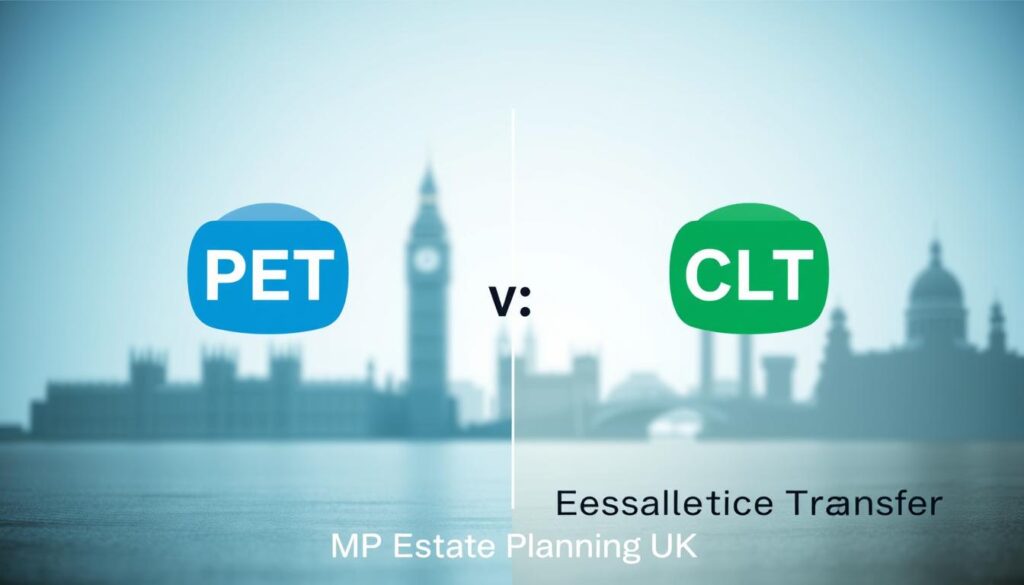Did you know that in the UK, gifts given during one’s lifetime can have significant implications for Inheritance Tax (IHT)? Understanding the differences between certain types of gifts is crucial for effective IHT planning.
We often encounter individuals who are unaware that lifetime transfers can be exempt, potentially exempt, or chargeable. This distinction is vital in determining the impact on IHT.
As we explore the nuances of potentially exempt transfers and chargeable lifetime transfers, we will use real UK examples to illustrate the differences and implications for IHT.
Key Takeaways
- Understanding the differences between potentially exempt and chargeable lifetime transfers is crucial for IHT planning.
- Certain gifts given during one’s lifetime can be exempt from IHT.
- Real UK examples will illustrate the implications of different types of gifts.
- Effective IHT planning requires knowledge of potentially exempt and chargeable transfers.
- IHT implications can vary significantly based on the type of gift given.
Understanding PETs and CLTs: Definitions and Differences
When considering gift strategies in the UK, understanding the nuances between Potentially Exempt Transfers (PETs) and Chargeable Lifetime Transfers (CLTs) is crucial. As we guide you through the complexities of estate planning, it’s essential to grasp the distinct characteristics of these transfer types and their implications for Inheritance Tax (IHT).
What is a PET (Potentially Exempt Transfer)?
A PET is a gift made to an individual or certain trusts, which becomes exempt from IHT if the donor survives for 7 years after making the gift. This type of transfer is typically used for gifting to family members or loved ones, providing a potentially tax-efficient way to pass on wealth. For instance, gifting a property or cash to your children could be considered a PET, provided you survive the 7-year period.
“PETs offer a flexible strategy for reducing IHT liabilities,” as noted by financial experts. “By making gifts that fall under PETs, individuals can significantly reduce the taxable value of their estate.”
What is a CLT (Chargeable Lifetime Transfer)?
A CLT, on the other hand, involves gifting assets into a relevant property trust. Unlike PETs, CLTs are subject to an immediate IHT charge if the transfer exceeds the nil-rate band. This means that CLTs can have immediate tax implications, making it crucial to carefully consider the amount and timing of such transfers. CLTs are often used for more complex estate planning strategies, such as setting up trusts for beneficiaries.
Key Differences Between PETs and CLTs
The primary difference between PETs and CLTs lies in their tax treatment and the conditions under which they are considered exempt or chargeable. PETs are generally more straightforward, becoming exempt if the donor survives 7 years, whereas CLTs are immediately chargeable to IHT if they exceed the nil-rate band. Understanding these differences is vital for choosing the most appropriate gift strategy for your circumstances.
- PETs are gifts to individuals or certain trusts, exempt if the donor survives 7 years.
- CLTs involve gifting to relevant property trusts, subject to immediate IHT if exceeding the nil-rate band.
- The choice between PETs and CLTs depends on your estate planning goals and the specific circumstances of your gifts.
By understanding the definitions and differences between PETs and CLTs, you can make informed decisions about your gift strategies and potentially minimize your IHT liabilities. We recommend consulting with a financial advisor to determine the best approach for your individual needs.
Inheritance Tax (IHT) in the UK: An Overview
In the UK, Inheritance Tax is a key consideration for individuals looking to manage their estate’s tax liability. As we navigate the complexities of estate planning, understanding IHT is crucial for making informed decisions about gifts and transfers.
What is Inheritance Tax?
Inheritance Tax is charged on the transfer of a deceased person’s estate to their beneficiaries. This includes property, money, and other assets. The tax is typically paid by the estate before the assets are distributed.
Current IHT Rates and Thresholds
The current IHT rate in the UK is 40% on the excess over the nil rate band, which is £325,000. There are also additional thresholds and reliefs that may apply, such as the residence nil rate band for those leaving a main residence to direct descendants.
| IHT Threshold | Tax Rate |
|---|---|
| £0 – £325,000 | 0% |
| £325,001 and above | 40% |
How Gifts Impact IHT Calculations
Gifts can significantly impact IHT calculations, especially if made within 7 years of death. Potentially Exempt Transfers (PETs) and Chargeable Lifetime Transfers (CLTs) are treated differently for IHT purposes. For instance, PETs become exempt if the donor survives for 7 years, while CLTs are immediately chargeable and may incur IHT.
For more detailed information on how gifts are treated for IHT, you can visit our page on Inheritance Tax and Capital Gains Tax on Inherited.

Real UK Examples of PETs
In the UK, Potentially Exempt Transfers (PETs) offer a flexible way to gift assets without incurring Inheritance Tax (IHT) liabilities, as we will explore through real-life examples. PETs are an essential tool in IHT planning, allowing individuals to make gifts that can be exempt from IHT if certain conditions are met.
Small Cash Gifts
One common example of a PET is gifting £3,000 per year, which is exempt from IHT under the annual exemption. For instance, if an individual gifts £3,000 to their child, this gift will be considered a PET and will not be subject to IHT if the donor survives for seven years after making the gift.
Additionally, gifts made from normal expenditure out of income are also considered PETs. For example, if someone regularly gifts a portion of their income to their grandchildren, these gifts can be exempt from IHT if they are considered part of their normal expenditure.
Transfers of Property
Another significant example of PETs involves transferring property to children or other beneficiaries. For instance, if a parent gifts a property to their child, this can be considered a PET. However, it’s crucial to ensure that the gift is made outright and that the donor does not continue to benefit from the property in a way that could be considered a “reserved benefit.”
To illustrate, if a parent gifts a holiday home to their children but continues to use it without paying market rent, HMRC might consider this a reserved benefit, potentially affecting the gift’s status as a PET. Therefore, it’s essential to seek professional advice when making such gifts.
Contributions to Trusts
Certain contributions to trusts can also be considered PETs. For example, contributions to bare trusts or disabled trusts can qualify as PETs. A bare trust is where the beneficiary has an absolute right to the trust assets, whereas a disabled trust is designed to benefit individuals who are disabled.
For more information on how trusts can be used in IHT planning, you may want to explore our resources on leaving a digital legacy to charity, which can also involve gifting assets in a tax-efficient manner.
By understanding and utilizing PETs effectively, individuals can significantly reduce their IHT liabilities, ensuring that more of their estate is passed on to their loved ones rather than being lost to tax. It’s essential to review your gifting strategy regularly and consider the implications of PETs and other gifting options as part of your overall IHT planning.
Real UK Examples of CLTs
Understanding CLTs is crucial for those looking to make significant gifts in the UK. Chargeable Lifetime Transfers can have immediate inheritance tax implications, making it essential to consider the various ways they can be utilised.
CLTs are often used in complex gift strategies, involving trusts or significant asset transfers. We will explore some real UK examples to illustrate how CLTs work in practice.
Example 1: Family Trusts
One common use of CLTs is gifting assets into discretionary trusts. For instance, a parent might set up a trust for their children, transferring a significant amount of wealth. This transfer is considered a CLT and may attract immediate inheritance tax if it exceeds the available nil-rate band.
For example, if a parent transfers £500,000 into a discretionary trust, and they have already used their nil-rate band, the excess amount may be subject to inheritance tax at the lifetime rate.
Example 2: Gifting Shares in a Company
Gifting shares in a company is another scenario where CLTs come into play. If a shareholder gifts shares to family members or a trust, this transfer can be considered a CLT. The value of the gift is calculated based on the value of the shares at the time of the transfer.
For instance, if an individual gifts shares worth £200,000 to a family member, and this gift exceeds their available nil-rate band, it will be treated as a CLT and may attract inheritance tax.

Example 3: Setting Up a Charity
Setting up a charitable trust is another example of a CLT. Gifts to charitable trusts can be significant and are often used to reduce inheritance tax liabilities. However, these gifts are considered CLTs and may have immediate tax implications.
For example, if an individual sets up a charitable trust with a gift of £1 million, this transfer will be treated as a CLT. While charitable gifts can offer tax relief, it’s crucial to understand the implications of such significant transfers.
These examples illustrate the various ways CLTs can be used in the UK, from family trusts to charitable giving. Understanding the tax implications of these transfers is vital for effective inheritance tax planning.
- CLTs can involve significant asset transfers, such as gifting shares or setting up trusts.
- These transfers can have immediate inheritance tax implications if they exceed the nil-rate band.
- Understanding the value of the gift at the time of transfer is crucial for calculating any tax liability.
Evaluating the IHT Implications of PETs
Understanding how Potentially Exempt Transfers (PETs) impact Inheritance Tax (IHT) is crucial for effective estate planning in the UK. PETs can be a valuable strategy for reducing IHT liability, but their implications must be carefully considered.
How PETs Save on Inheritance Tax
PETs can save on IHT if the donor survives for 7 years after making the gift. This is because PETs are considered potentially exempt from IHT, provided they are outright gifts to individuals or certain trusts. By making PETs, individuals can significantly reduce the value of their estate, thereby minimising the IHT burden on their beneficiaries.
To illustrate, let’s consider a simple example. If an individual makes a PET of £100,000 and survives for 7 years, this amount is not subject to IHT. This can result in significant tax savings, especially for larger estates.
Conditions for PETs to be IHT-Free
For PETs to be considered IHT-free, certain conditions must be met. These include:
- The gift must be an outright transfer to an individual or certain trusts.
- The donor must survive for 7 years after making the gift.
- The gift must not be part of a larger, more complex arrangement that could be considered a Chargeable Lifetime Transfer (CLT).
It’s also worth noting that if the donor dies within 7 years, the PET becomes chargeable, and IHT may be applicable. However, taper relief can reduce the IHT liability if the donor survives for more than 3 years.
Case Study: Successful PET Scenario
Let’s examine a case study to understand the successful application of PETs. Mr. Smith, a widower, decides to gift his daughter £200,000 to help her purchase a home. He survives for more than 7 years after making the gift. As a result, the £200,000 is not considered part of Mr. Smith’s estate for IHT purposes, potentially saving a significant amount in IHT.

| Years Survived | IHT Liability | Taper Relief |
|---|---|---|
| 0-3 | Full IHT liability | No taper relief |
| 3-4 | Reduced IHT liability | 20% taper relief |
| 4-5 | Further reduced IHT liability | 40% taper relief |
| 5-6 | IHT liability reduced | 60% taper relief |
| 6-7 | IHT liability minimal | 80% taper relief |
| 7+ | No IHT liability | 100% taper relief |
This case study demonstrates how PETs can be effectively used to minimise IHT liability, providing a clear benefit to both the donor and the beneficiaries.
Evaluating the IHT Implications of CLTs
When considering Chargeable Lifetime Transfers (CLTs), it’s crucial to understand their implications on Inheritance Tax (IHT) in the UK. CLTs can have a significant impact on your tax liability, and navigating these implications is essential for effective tax planning.
When CLTs Attract Inheritance Tax
CLTs attract IHT if they exceed the nil rate band. The nil rate band is the amount up to which transfers are exempt from IHT. Currently, this band is set at £325,000, although it can change based on various factors, including the transferor’s residence and the nature of the transfer.
To understand when CLTs attract IHT, consider the following:
- The cumulative total of CLTs made during the transferor’s lifetime.
- The value of the CLT at the time it is made.
- Any available exemptions or reliefs that may apply.
Strategies to Minimise IHT on CLTs
Minimising IHT on CLTs requires careful planning. Here are some strategies to consider:
- Utilising the annual exemption allowance.
- Making gifts that fall within the exemptions for normal expenditure out of income.
- Considering the use of trusts to manage and distribute wealth.
By employing these strategies, individuals can reduce their IHT liability and ensure that more of their wealth is passed on to their beneficiaries.
| Strategy | Description | Potential IHT Saving |
|---|---|---|
| Annual Exemption Allowance | Utilise the annual allowance to make gifts without incurring IHT. | Up to £3,000 per year |
| Normal Expenditure Out of Income | Gifts made from surplus income that are considered normal expenditure. | Variable, based on income level |
| Trusts | Using trusts to manage and distribute wealth, potentially reducing IHT. | Variable, based on trust structure |
Case Study: Managing a CLT for Family Wealth
Let’s consider a case study where an individual, Mr. Smith, makes a CLT to a trust for his grandchildren. The transfer is valued at £400,000, exceeding the nil rate band. To minimise IHT, Mr. Smith utilises his annual exemption allowance and structures the trust to benefit from available reliefs.
By doing so, Mr. Smith reduces the IHT liability on the transfer, ensuring that more of his wealth is preserved for his family.

In conclusion, understanding the IHT implications of CLTs and employing effective strategies to minimise tax liability can significantly impact the preservation of family wealth.
Comparing PETs and CLTs: Which is Best?
In the realm of UK inheritance tax planning, PETs and CLTs are two distinct options that serve different purposes. Understanding their differences is crucial for making informed decisions about gifting strategies.

Advantages of Using PETs
PETs are advantageous for outright gifts, providing a straightforward way to transfer assets without incurring inheritance tax, provided the donor survives for seven years after the gift.
Key benefits of PETs include:
- Simplicity in gifting
- Exemption from inheritance tax if the donor survives for seven years
- No need for complex trust arrangements
Benefits of Choosing CLTs
CLTs are necessary for gifts into certain trusts, offering a way to manage and distribute assets according to specific conditions. They are particularly useful for gifts that are not outright.
The benefits of CLTs include:
- Flexibility in managing gifts through trusts
- Ability to set conditions for the gift
- Useful for gifts that are not outright
Situational Factors for Decision-Making
The choice between PETs and CLTs depends on the donor’s circumstances and goals. Factors such as the type of gift, the recipient, and the donor’s intentions play a significant role in this decision.
When deciding between PETs and CLTs, consider the following:
- The nature of the gift (outright or conditional)
- The donor’s financial situation and goals
- The potential impact on inheritance tax
Common Misconceptions About PETs and CLTs
Clarifying common misconceptions about PETs and CLTs can help individuals make informed decisions about their estate planning. We often encounter misconceptions that can lead to costly mistakes in inheritance tax planning.
Myth: All Gifts Are Tax-Free
Many believe that all gifts are tax-free, but this is not the case. PETs (Potentially Exempt Transfers) and CLTs (Chargeable Lifetime Transfers) have different tax implications. For instance, PETs are exempt from inheritance tax if they survive the seven-year taper relief period, whereas CLTs are immediately chargeable and may incur tax.
Myth: One Transfer Type is Always Better
Some individuals assume that one type of transfer is always superior to the other. However, the choice between PETs and CLTs depends on individual circumstances. For example, PETs are often preferred for smaller gifts, while CLTs might be more suitable for larger transfers or when setting up trusts.
Myth: Timing Doesn’t Matter for IHT Planning
Timing is crucial when it comes to inheritance tax planning. Making gifts too close to one’s passing can result in those gifts being subject to inheritance tax. Understanding the seven-year rule and how it applies to PETs can help in planning.
| Transfer Type | Tax Implications | Best For |
|---|---|---|
| PETs | Exempt if survive 7-year period | Smaller gifts, straightforward transfers |
| CLTs | Immediately chargeable | Larger transfers, setting up trusts |
For more detailed information on business succession planning and its relation to IHT, you can visit our page on business succession planning.

Legal Considerations for PETs and CLTs
Navigating the legal aspects of PETs and CLTs is essential for effective gift planning in the UK. We understand that making informed decisions about gifts involves more than just understanding the types of transfers available; it also requires a grasp of the legal framework that governs them.
Legal Framework Surrounding Gifts in the UK
The legal framework for gifts in the UK is primarily governed by Inheritance Tax (IHT) laws and regulations. These laws dictate how gifts are treated for tax purposes and outline the conditions under which they may be exempt from IHT or subject to it. Understanding these regulations is crucial for ensuring that gifts are made in a tax-efficient manner.
The current IHT laws in the UK provide a framework for both PETs and CLTs, detailing the conditions under which they are considered exempt or chargeable. For instance, PETs are exempt from IHT if the donor survives for seven years after making the gift. In contrast, CLTs are immediately chargeable to IHT, although they may benefit from certain reliefs and exemptions.
Importance of Proper Documentation
Proper documentation is vital when making gifts through PETs or CLTs. Accurate records of gifts, including the date, value, and nature of the gift, are necessary to ensure compliance with IHT regulations. Incomplete or inaccurate documentation can lead to disputes with HMRC and potentially result in unforeseen tax liabilities.
To avoid such issues, it is advisable to maintain detailed records of all gifts made, including:
- The value of the gift at the time of transfer
- The relationship between the donor and the recipient
- Any relevant exemptions or reliefs claimed
Potential Legal Challenges with Transferring Wealth
Transferring wealth through gifts can sometimes lead to legal challenges, particularly if the gifts are not properly documented or if they are contested by other family members or beneficiaries. It is essential to seek professional advice to mitigate these risks and ensure that gifts are made in accordance with the donor’s wishes and legal requirements.
Legal challenges can arise in various forms, including disputes over the validity of the gift, allegations of undue influence, or claims that the gift was made under duress. Proper planning and documentation can help minimize these risks.
Expert Advice on Gift Strategies in the UK
Navigating the world of gifts in the UK requires a deep understanding of PETs and CLTs, and how they impact your Inheritance Tax liability. As we explore the intricacies of gift strategies, it’s essential to consider expert advice to make informed decisions.
Consulting with Financial Advisors
Consulting with financial advisors is a crucial step in developing a gift strategy that aligns with your financial goals and minimizes Inheritance Tax. Financial advisors can provide personalized guidance on whether to use PETs or CLTs based on your individual circumstances. For instance, they can help you assess the potential tax implications of gifting and advise on the most beneficial transfer type.
When seeking advice, consider the following key factors:
- The value of the gifts you intend to make
- Your current financial situation and future prospects
- The potential impact of Inheritance Tax on your estate
- The benefits and drawbacks of PETs versus CLTs
Tax Planning Strategies to Consider
Effective tax planning is vital when making gifts to minimize Inheritance Tax liability. One key strategy is to consider the cumulative effect of gifts and the donor’s survival period. For example, gifts made within seven years of the donor’s passing can be subject to Inheritance Tax, depending on the type of gift and the tax laws at the time.
Some tax planning strategies to consider include:
- Utilizing annual gift allowances to reduce the value of your estate
- Making regular gifts from income to reduce Inheritance Tax liability
- Considering the use of trusts to manage gifts and minimize tax
For more detailed information on gifting and Inheritance Tax, you can visit M&G Wealth, which provides comprehensive guidance on the subject.
Importance of Regular Reviews of Gifts and Assets
Regular reviews of your gifts and assets are essential to ensure that your gift strategy remains aligned with your overall financial objectives and adapts to any changes in tax legislation or personal circumstances. This includes reviewing the performance of gifted assets, assessing any changes in tax laws, and adjusting your strategy as needed.
Key aspects to review regularly include:
- The value and performance of gifted assets
- Changes in tax laws or regulations that may impact your gifts
- Any shifts in your personal financial situation or goals
By staying informed and regularly reviewing your gift strategy, you can ensure that you are making the most effective use of PETs and CLTs to minimize Inheritance Tax and achieve your financial goals.
Conclusion: Making Informed Gift Choices
As we have explored the differences between PETs and CLTs, and examined real UK examples, it’s clear that understanding these gift strategies is crucial for effective Inheritance Tax (IHT) planning. We will now summarize the key takeaways and provide insights on how to make informed decisions.
Key Considerations for PETs and CLTs
When deciding between PETs and CLTs, it’s essential to consider your individual circumstances and financial goals. PETs can be an attractive option for those looking to make gifts without incurring immediate IHT charges. For instance, PET vs CLT examples UK demonstrate how gifts between individuals can be made without triggering IHT, provided certain conditions are met.
Proactive Financial Planning for IHT
Proactive financial planning is vital to minimize IHT liabilities. We recommend consulting with financial advisors to determine the best gift strategy for your situation. By doing so, you can ensure that your gifts are made in a tax-efficient manner, taking advantage of the benefits of PET over CLT where applicable.
Minimizing IHT Through Gift Strategies
In conclusion, making informed gift choices requires a thorough understanding of PETs and CLTs, as well as their implications for IHT. By carefully evaluating your options and seeking professional advice, you can create a effective gift strategy that minimizes IHT liabilities and protects your family’s assets.


